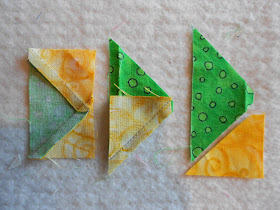 Thanks again to whomever let the great yellow be released from their stash. I love the gift! I think it makes an amazing background. Let's just say the sun is making my block bloom.
Thanks again to whomever let the great yellow be released from their stash. I love the gift! I think it makes an amazing background. Let's just say the sun is making my block bloom.
Looking at all the pieces arranged on my mini design board, it sure looks like a mess. This block went together really well for me. I do have to admit after I cut the diamonds, I couldn't figure out which one went where. I almost cut new pieces because I was convinced that I had cut them incorrectly.
Cutting:
Background
- 7 - 1 1/2" finished half squares (2" strip EA)
- 2 - 2" X 5" rectangles
- 2 each -2" x 3 1/2" rectangles
I am hoping the take-away method is getting a little easier for all of you. If you still have questions, re-read this post for a refresher.
Lay both your petals and leaves wrong sides together (so you get a reversed piece)
Double check that your pieces are 2" x 3 1/2" and line up the 2" stitch line of the easy angle on the corner. Use your take-away template (if you made one) to double check yourself.
Place your template in the opposite corner to cut away the triangle making a diamond shape.
 Lay out all your pieces to make sure everything is cut correctly. Sew 2 triangles on each of the flower petals (refer to final illustration to see how I pressed). Use your easy angle see if your pieces are the correct size (3" finished half square lined up with the 3 1/2" line). Sew together the two triangles to make a 3 1/2" square. Add the leaf units to the right and bottom of the square.
Lay out all your pieces to make sure everything is cut correctly. Sew 2 triangles on each of the flower petals (refer to final illustration to see how I pressed). Use your easy angle see if your pieces are the correct size (3" finished half square lined up with the 3 1/2" line). Sew together the two triangles to make a 3 1/2" square. Add the leaf units to the right and bottom of the square. Add the larger vase piece to the flower unit to make a 5" Square. When You sew the flower & leaf unit to the vase, sew with the vase next to the feed dogs. This will help you see your "X" where you want your seam to go and give you a perfect point on your flower. Sew the remaining half square and join it with one of the background pieces. Attach the remaining two pieces to complete the 6 1/2" block
Add the larger vase piece to the flower unit to make a 5" Square. When You sew the flower & leaf unit to the vase, sew with the vase next to the feed dogs. This will help you see your "X" where you want your seam to go and give you a perfect point on your flower. Sew the remaining half square and join it with one of the background pieces. Attach the remaining two pieces to complete the 6 1/2" block
This is how I pressed my block to get everything to nestle together. Let me know if you have questions or problems. After 111 blocks, you all will be experts with the Easy Angle and Companion Angle (or dislike me)































